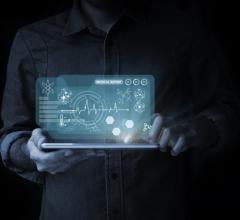
Today's cardiovascular information systems need to incorporate all facets of the cardiology department, including subspecialties, to allow a complete picture of a patient's record. These data also need to be able to be shared with enterprise data systems, such as the electronic medical record (EMR). This image is from ScImage, illustrating the various aspects that integrate to make up a complete CVIS.
Cardiovascular information and imaging systems (CVIS) have existed for many years in the dedicated sub-specialty areas. In a noninvasive department, a physician may have used an echo picture archiving and communication system (PACS) to access imaging and generate a structured report. Across the hall in the invasive department, the same physician would scrub in the cath lab and a different set of applications would be used for hemodynamics (hemo) and cath lab image access. This type of environment seemed to meet the need in the fee-for-service (FFS) model, but with the increasing demand for value-based care and integrated healthcare delivery (IDN), providers are seeking for ways to consolidate all generated data points and imaging in one location.
Whether you are a cardiologist, a vascular surgeon, a technologist or a cardiovascular (CV) department manager, the patient data generated in the course of an encounter has to be presented in a single portal with seamless effort for review, sharing, manipulation, reporting and analytics. Today’s market offers a wide variety of CVIS choices that are considered to be consolidated or integrated solutions that include all areas of a CV department. As a customer, these options become increasingly overwhelming, especially when recent investments may be limiting your ability to simply replace all legacy systems with one new integrated solution.
When the decision has been made to research the CVIS market for potential solutions, it is critical to understand that the sales and marketing material is not necessarily what the implementation results offer. After leading several CVIS implementations and post-implementations, I have discovered a consistent list of items that continue to appear as significant gaps within purchasing agreements. In this article, I will discuss five key questions to raise and address as providers in the procurement process. These questions are generated based on recent lessons learned from several luminary IDNs that have implemented an integrated CVIS solution.
Sentara Health in Virginia is going through the process of choosing a new cardiovascular information system (CVIS) and implementing enterprise imaging. Sentara's IT leader shares information on what elements they are looking for and how they plan to wire their system to achieve a new level of interoperability for cardiology. Watch the video “What to Look for in a New Cardiovascular Information System.
1. How does the CVIS vendor address EHR integration gaps?
Similar to any clinical system, the CVIS is simply a piece of a large healthcare IT puzzle. Since the electronic health record (EHR) has become the master system of record, it is critical that CVIS is well integrated with the enterprise EHR to avoid patient record gaps and to have the ability to generate thorough analytics. One of the main challenges with CVIS and EHR is the lack of discrete data flow between the two systems. If the hemo system is native to CVIS, there is relatively more data exchange between CVIS and EHR, but this still requires customization. If a third-party hemo system is in place, the additional integration creates a barrier to discrete data exchange for items such as labs, medication, vital signs and utilized supplies, to name a few. In these cases, a static report is generated and the data is locked within a document. Procedure notes taken during a case provide richness to the patient record, and most of the time, these data remain in the hemo or CVIS due to the integration barriers.
2. How does the CVIS vendor support third-party archive integration?
The majority of integrated CVIS solutions in the market offer a native short-term storage that is tightly integrated for DICOM structured reporting (DSR) exchange. This short-term storage is typically referred to as cardiology PACS (CPACS). In addition to the online CPACS, most vendors now also offer a vendor neutral archive (VNA) in their product portfolio. If your enterprise has recently implemented a third party VNA for enterprise imaging (EI) strategy, it is crucial to understand how the CVIS vendor’s CPACS will integrate with the third-party VNA. Image object change management (IOCM) certification, an Integrating the Healthcare Enterprise (IHE) standard, has become an accepted industry benchmark to ensure that image objects stay in sync as they are routed through various repositories (though not all vendors are yet accommodating this IHE profile). Your organization may choose to keep the department system or the enterprise VNA as the source of truth, and having a CVIS/CPACS vendor with IOCM certification would be a strong starting point. Physicians rely on data and image integrity, and ensuring that measures have been implemented will create more ease as the CVIS changes take place.
In addition to image object integrity, the timely access to and reliability of image data is a key. As the procurement occurs, the CVIS/CPACS vendor needs to ensure that the third-party VNA integration will not create any access delays. If your organization has chosen an enterprise clinical viewer (ECV) for physician access via VNA integration, then the acquired images routed to CPACS need to be instantly available in the VNA for STEMI-type cases. The integration between CVIS/CPACS and VNA needs to be addressed during the procurement discussion in order to ensure that there are no delays once the system is implemented.
3. Does the CVIS vendor address specialty workflows in an enterprise model?
The primary goal of the integrated CVIS is to ensure that all CV services are incorporated within a single enterprise solution. The caveat of this objective is the loss of workflow attention at the department or sub-specialty levels. Most integrated CVIS solutions have somewhat optimized the workflow within echo reporting as the piloting module. However, there are still a number of workflow gaps that exist in the cath lab, electrophysiology (EP), vascular and nuclear medicine reporting, and therefore the adoption has been sluggish. These gaps vary depending on the solution. Traditionally, each sub-specialty found unique ways to address the workflow, and an enterprise solution has to be adequately flexible to allow such customization. Understanding the current state workflow and ensuring that the new CVIS will offer the sub-specialty tools will be essential to the physician adoption success. Outside of the physician reporting workflow, such as the image ingestion process from outside organizations, could be another example of a requirement that should be discussed to ensure the new CVIS/CPACS has built-in tools with minimal manual intervention. Other department-level workflow gaps may be found, but are somewhat subjective based on the organization type. (Watch the video “Creating an Enterprise Imaging System, an interview with Kim Garriott, principal consultant, Logicalis Inc., and Jef Williams, Paragon Consulting Partners, explaining details of how to create an enterprise imaging system at the Radiological Society of North America (RSNA) 2015 meeting.)
4. How does the CVIS vendor address quality and value-based analytics requirements?
One of the main challenges in the CV care continuum is the ability to aggregate all discrete clinical, business and quality data and have it presented for business intelligence and at the point-of-care. It is extremely frustrating for operational leadership when they are unable to develop a business strategy when a cost-per-case metric takes days to generate — with questionable results. In the technology era, this type of data should not take several days for an FTE to generate and then question the integrity with additional cross-checking. In an integrated CVIS environment, ability to ingest, store and manipulate data is considered a basic tool. With the ongoing evolution of value-based care, CV leadership is mandated to partner with a CVIS vendor that has the ability to aggregate all the discrete data and provide intelligent tools for reporting and presentation. The reports should be live and readily available with accurate data and reliable tools. Furthermore, the data should be freely accessible to the organization regardless of reporting tools the customer chooses to utilize.
5. Is the CVIS vendor product roadmap relevant to your organization’s strategy?
As a customer in the CVIS market, the procurement of the system essentially becomes a marriage, not a date. Thorough understanding of current features and functionality is critical, but equally as important is the vendor’s outlook on the CVIS market and healthcare as a whole. Healthcare is changing rapidly and the vendors are under ongoing pressure to stay agile and innovative. Is the CVIS vendor’s next set of functionality scheduled for release in-line with your organization? If not, is the vendor willing to partner with your key stakeholders to collect and design specific system functions/tools that will address significant gaps in the following years? On the other hand, is the CVIS vendor releasing upgrades every four weeks, creating a support nightmare for your CVIS administrators? It is a fine balance in the growing healthcare field and the CVIS vendor partnership needs to start during the procurement process. A CVIS vendor’s ability to quickly turn around certain functionality and work closely with your needs will establish a strong bond with your key stakeholders.
The integrated CVIS market is maturing every day, but there is still a growing list of gaps that need to be addressed as you engage in the shopping journey. To have an honest and fruitful discussion with the CVIS vendors, it is important to understand both your organization’s current state of affairs and the strategy when it comes to CV systems and workflow. As you begin to dive into the clinical, technical and operational analysis of your services, there will be more than five questions to consider, but this will be a healthy start.
Watch the Video “What to Look for in CVIS and PACS Workflow Efficiency for examples of technologies on the market and a discussion of what to look for in PACS and CVIS workflow efficiencies with Paragon Consulting Partners consultant Jef Williams. Editor Dave Fornell takes viewers on a tour of key workflow improvements offered by health IT vendors at HIMSS 2016.
CVIS Comparison Chart
This article served as an introduction to a the cardiovascular information system (CVIS) / cardiac PACS product comparison chart. To access the chart, go to www.dicardiology.com/content/cardiac-pacs. Access requires a login, but to create one is free and only takes a moment.
Link to GE Healthcare's Interactive, Digital Guide for Centricity Cardio Enterprise
Editor’s note: Val Kapitula, RT(R), PMP, CIIP, is a healthcare IT consultant/partner at Paragon Consulting Partners. The healthcare IT advisory and consulting firm focuses on having fun and doing right by its clients in healthcare. Paragon specializes in enterprise imaging strategy, system procurement and implementation with a focus on the clinical, operational and technical verticals of healthcare. www.paragonconsultingpartners.com


 June 27, 2022
June 27, 2022 








